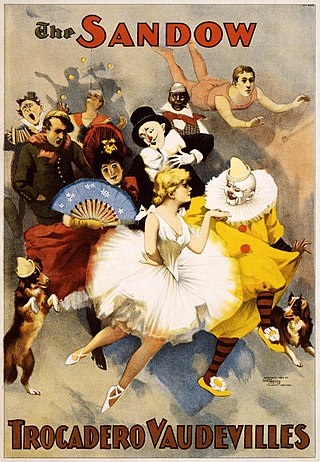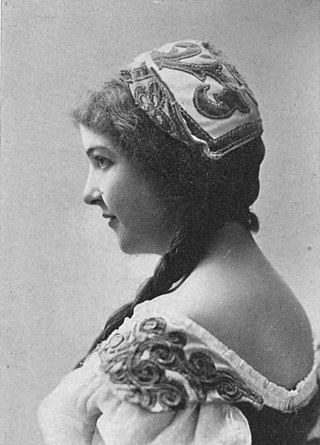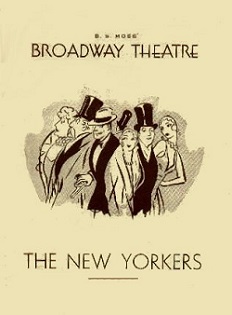Related Research Articles

Vaudeville is a theatrical genre of variety entertainment which began in France at the end of the 19th century. A vaudeville was originally a comedy without psychological or moral intentions, based on a comical situation: a dramatic composition or light poetry, interspersed with songs or ballets. It became popular in the United States and Canada from the early 1880s until the early 1930s, while changing over time.

Adele Astaire Douglass, was an American dancer, stage actress, and singer. After beginning work as a dancer and vaudeville performer at the age of nine, Astaire built a successful performance career with her younger brother, Fred Astaire.

Lincoln Center for the Performing Arts is a 16.3-acre (6.6-hectare) complex of buildings in the Lincoln Square neighborhood on the Upper West Side of Manhattan. It has thirty indoor and outdoor facilities and is host to 5 million visitors annually. It houses internationally renowned performing arts organizations including the New York Philharmonic, the Metropolitan Opera, the New York City Ballet, the Chamber Music Society of Lincoln Center and the Juilliard School.

The Metropolitan Opera is an American opera company based in New York City, currently resident at the Metropolitan Opera House at Lincoln Center, situated on the Upper West Side of Manhattan. The company is operated by the non-profit Metropolitan Opera Association, with Peter Gelb as the general manager. The company's music director has been Yannick Nézet-Séguin since 2018.
Drag is a performance of exaggerated femininity, masculinity, or other forms of gender expression, usually for entertainment purposes. Drag usually involves cross-dressing. A drag queen is someone who performs femininely and a drag king is someone who performs masculinely. Performances often involve comedy, social satire, and at times political commentary. The term may be used as a noun as in the expression in drag or as an adjective as in drag show.

New York City has been described as the cultural capital of the world. The culture of New York is reflected in its size and ethnic diversity. As many as 800 languages are spoken in New York, making it the most linguistically diverse city in the world. Many American cultural movements first emerged in the city. Large numbers of Irish, Italian, Jewish, and eventually Asian, African, and Hispanic Americans also migrated to New York throughout the 20th century and continuing into the 21st century, significantly influencing the culture and image of New York. The city became the center of stand-up comedy in the early 20th century. The city was the top venue for jazz in the 1940s, expressionism in the 1950s and home to hip hop, punk rock, and the Beat Generation. Along with London, New York City is the global center of musical theatre, often referred to as "Broadway" after the major thoroughfare in Manhattan. The Stonewall Inn in Greenwich Village, Lower Manhattan, is a designated U.S. National Historic Landmark and National Monument, as the site of the June 1969 Stonewall riots and the cradle of the modern gay rights movement.

The Palace Theatre is a Broadway theater at 1564 Broadway, facing Times Square, in the Midtown Manhattan neighborhood of New York City. Designed by Milwaukee architects Kirchhoff & Rose, the theater was funded by Martin Beck and opened in 1913. From its opening to about 1929, the Palace was considered among vaudeville performers as the flagship of Benjamin Franklin Keith and Edward Franklin Albee II's organization. The theater had 1,743 seats across three levels as of 2018.

A music venue is any location used for a concert or musical performance. Music venues range in size and location, from a small coffeehouse for folk music shows, an outdoor bandshell or bandstand or a concert hall to an indoor sports stadium. Typically, different types of venues host different genres of music. Opera houses, bandshells, and concert halls host classical music performances, whereas public houses ("pubs"), nightclubs, and discothèques offer music in contemporary genres, such as rock, dance, country, and pop.

Antony and Cleopatra, Op. 40, is an opera in three acts by American composer Samuel Barber. The libretto was prepared by Franco Zeffirelli. It was based on the play Antony and Cleopatra by William Shakespeare and made use of Shakespeare's language exclusively.

The Orpheum Theatre, a 2,308-seat venue listed on the National Register of Historic Places, is located in downtown Memphis, Tennessee, on the southwest corner of the intersection of South Main and Beale streets. The Orpheum, along with the Halloran Centre for Performing Arts & Education, compose the Orpheum Theatre Group, a community-supported nonprofit corporation that operates and maintains the venues and presents education programs.

Alice Nielsen was an American Broadway performer and operatic soprano who had her own opera company and starred in several Victor Herbert operettas.

The New Yorkers is a musical written by Cole Porter and Herbert Fields (book). Star Jimmy Durante also wrote the words and music for the songs in which his character was featured.

George Walker was an American vaudevillian, actor, and producer. In 1893, in San Francisco, Walker at the age of 20 met Bert Williams, who was a year younger. The two young men became performing partners. Walker and Williams appeared in The Gold Bug (1895), Clorindy (1898), The Policy Player (1899), Sons of Ham (1900), In Dahomey (1903), Abyssinia (1906), and Bandanna Land (1907). Walker married dancer Ada Overton, who later also was a choreographer.

Terry's Theatre was a West End theatre in the Strand, in the City of Westminster, London. Built in 1887, it became a cinema in 1910 before being demolished in 1923.

The Metropolitan Opera House, also known as the Old Metropolitan Opera House and Old Met, was an opera house located at 1411 Broadway in Manhattan, New York City. Opened in 1883 and demolished in 1967, it was the first home of the Metropolitan Opera.
William Hammerstein was an American theater manager. He ran the Victoria Theatre on what became Times Square, Manhattan, presenting very popular vaudeville shows with a wide variety of acts. He was known for "freak acts", where celebrities or people notorious for scandals appeared on stage. Hammerstein's Victoria Theatre became the most successful in New York.

The Slipper Room is a variety theatre and house of burlesque, comedy and neo-vaudeville, located in the Lower East Side district of Manhattan, New York City.

Valentina Kachouba, also written as Valentine Kashuba, was a Russian ballet dancer, a member of Diaghilev's Ballets Russes company from 1916 and 1921; as one of the last surviving members of the troupe, her memories and photographs were considered especially valuable as a record of the ballet and its members.

Annamary Dickey, also known as Annamary Dickey Laue, was an American soprano and actress in operas, operettas, musicals, night clubs, and concerts who had an active performance career from the 1930s through the 1960s. She began her career as a regular performer with the Chautauqua Opera and the St. Louis Municipal Opera in the mid to late 1930s. In 1939 she won the Metropolitan Opera Auditions of the Air which earned her a contract with the Metropolitan Opera (Met). She was a soprano in mainly secondary roles at the Met from 1939 to 1944; appearing in productions of Gluck's Orfeo ed Euridice, Massenet's Manon, Delibes' Lakmé, Charpentier's Louise, Bizet's Carmen, Der Rosenkavalier by Richard Strauss, Mozart's The Marriage of Figaro, and Smetana's The Bartered Bride. Her most significant role at the Met was as Musetta in Puccini's La bohème. A strikingly beautiful woman with a passion for fashionable clothes, she gained the moniker the "Glamour Girl of the 'Met'" and headlined a fashion campaign for Saks Fifth Avenue in 1945.
References
- ↑ In 1947, Alf Landon, a Republican presidential nominee, was denied entry because he was wearing a business suit. "Opera Club Bars Landon". The New York Times . Vol. 97, no. 32, 835. December 18, 1947. p. 30.
- ↑ Bonner 1949, pp. 16–17.
- 1 2 3 4 Charles Cooke; Russell Maloney (22 February 1936). "Opera Club". The New Yorker : 11.
- ↑ Bonner 1949, p. 16.
- ↑ Ward & Volkes, performingartsarchive.com
- ↑ Walter Jones (1874–1922), basinstreet.com
- ↑ Papinta dances the Serpentine Dance, 1890s on YouTube
- ↑ Bonner 1949, p. 17.
- ↑ Bonner 1949, p. 18.
- ↑ "Omnibus". The New Yorker: 18. 10 November 1928.
- ↑ Bonner 1949, pp. 18–19.
- ↑ Bonner 1949, p. 19.
- ↑ Bonner 1949, pp. 32–33.
- ↑ "Support of the Met". The Metropolitan Opera Club. Retrieved 30 October 2016.
Sources
- Bonner, Eugene (1949). The Club in the Opera House: The Story of the Metropolitan Opera Club. New York: The Metropolitan Opera Club.